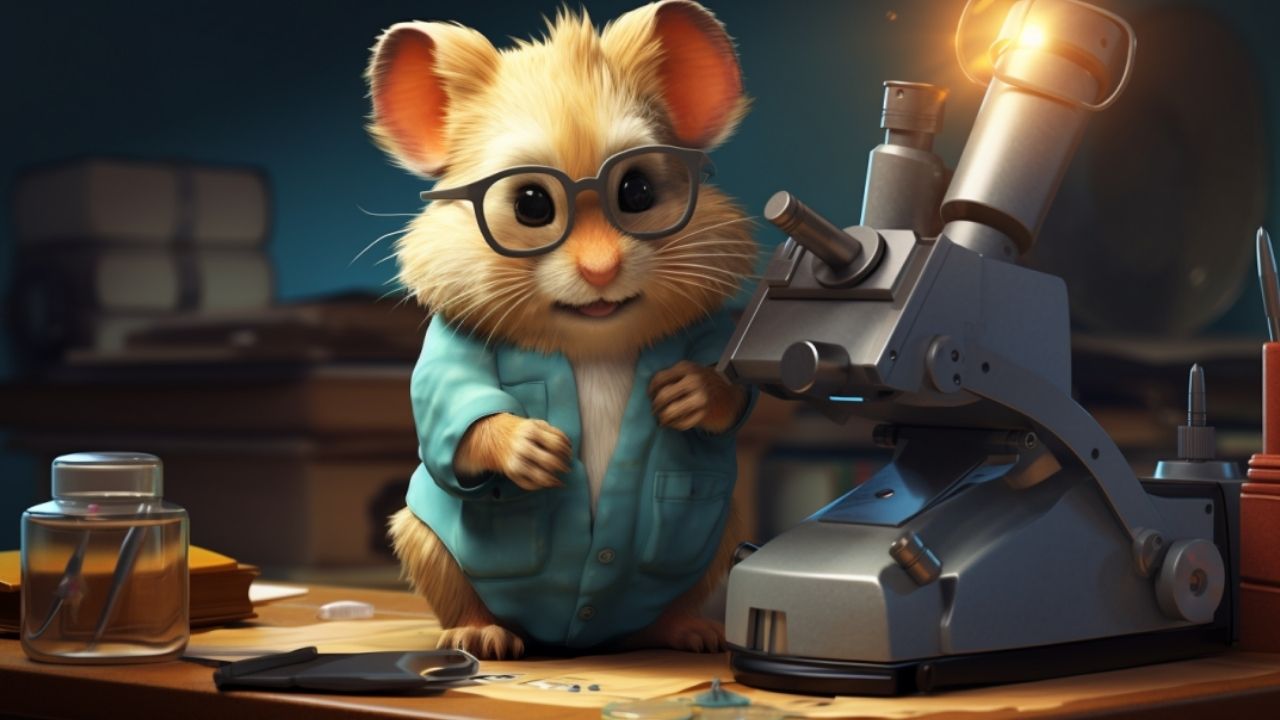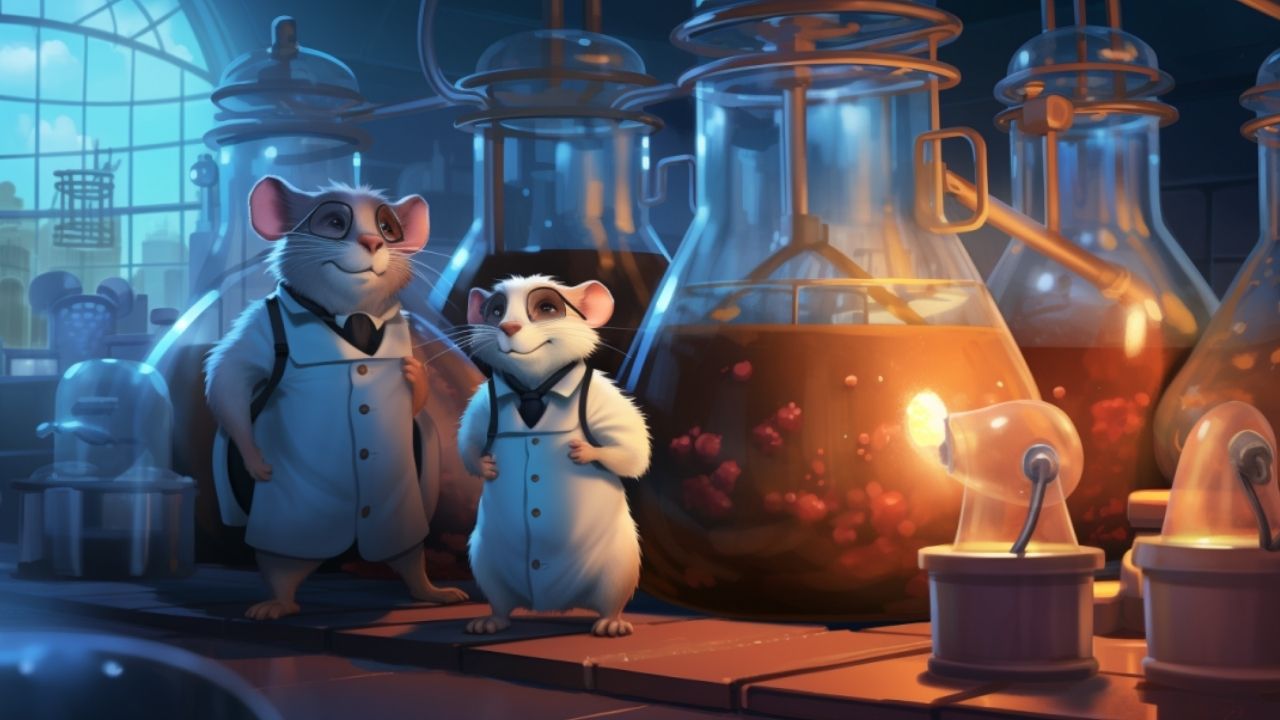When we think of hamsters, the general image that often comes to mind is that of a cute, round, furball scurrying around in a cage, enjoying its wheel or feasting on sunflower seeds. However, beneath that charming exterior lies a world teeming with fascinating complexities. From their unique genetic makeup to their intriguing behaviors, hamsters are more than just adorable pets; they’re a testament to the marvels of Mother Nature.
Understanding the Depth and Diversity of Hamster Biology and Behavior
The world of hamsters is a vibrant tapestry of biology, behavior, and adaptation. Every twitch of their whiskers, every turn in their burrow, is a culmination of millions of years of evolution. Their behaviors are not just random antics but are deeply rooted in their biology and evolutionary history. For instance, while many may know that hamsters store food in their cheek pouches, few might be aware of the intricate biological mechanisms that facilitate this.
Why Advancing Your Knowledge About Hamsters is Beneficial
Delving deeper into the intricacies of hamsters does more than just satiate our curiosity. It enhances our ability to care for these creatures by anticipating their needs, understanding their reactions, and adapting our care practices accordingly. Furthermore, a more profound appreciation for hamsters can lead to enriched interactions and a more fulfilling pet ownership experience. After all, understanding leads to empathy, and empathy leads to care. So, let’s embark on this journey to uncover the less-traveled paths of hamster knowledge together.
The Genetics of Hamsters: A World in Microcosm

In every living creature, a vast universe of genetic codes dictates everything from the color of their eyes to their predisposition to certain behaviors. Hamsters are no exception to this intricate dance of genes. Understanding the genetics of these small rodents gives us a clearer picture of their unique characteristics and tendencies. It’s a field that offers remarkable insights, not just into the individual hamster, but into the broader strokes of biology and evolution.
Exploring the Complexities of Hamster Genetics and Their Implications for Breeding and Health
Genes play a pivotal role in determining a hamster’s health, appearance, and even their lifespan. For breeders and enthusiasts, understanding genetics is crucial, especially when aiming for specific traits or colors. It’s more than just matching two hamsters of a similar hue; it’s about understanding dominant and recessive genes and how they can combine in offspring.
But it’s not just about appearance. Genetics can also provide clues about potential health issues a hamster might face. Certain genetic markers can indicate a predisposition to diseases or conditions, allowing for preemptive care or specialized attention.
The Role of Genetics in Hamster Behavior and Appearance
While the environment plays a part, genetics can heavily influence a hamster’s behavior. For instance, some hamsters might have a genetic inclination towards being more nocturnal than others. Likewise, certain behaviors, like hoarding food or creating specific nesting patterns, might be deeply embedded in a hamster’s DNA.
Appearance-wise, genetics dictate everything from the length of a hamster’s fur to the patterns on its body. It’s not just about color but also about the texture of the fur, the size of the eyes, and even the shape of their ears. Recognizing the role of genetics in these traits helps enthusiasts appreciate the depth and diversity of the world of hamsters.
Biochemistry and the Hamster: A Look Inside

Biochemistry, the study of the chemical processes within living organisms, offers a lens into the intricate and often astounding mechanisms that keep creatures alive and functioning. With hamsters, this realm reveals surprising facts that underscore their uniqueness in the animal kingdom. From their metabolic pathways to their ability to handle certain substances, the internal chemistry of hamsters is nothing short of fascinating.
Delving into the Fascinating World of Hamster Enzymes and What They Reveal About Hamster Dietary and Metabolic Needs
Enzymes are biocatalysts – proteins that accelerate chemical reactions in the body. In hamsters, certain enzymes are tailored to their specific dietary and metabolic requirements. For instance, the presence of specific digestive enzymes helps them break down seeds, nuts, and vegetables, their primary food sources in the wild.
But it’s not just about digestion. The metabolism of hamsters, as seen through their enzymatic pathways, reveals that they can process substances differently from other animals. The presence of enzymes like alcohol dehydrogenase in their liver is a testament to their unique biochemistry. This particular enzyme, for example, allows them to break down alcohol, highlighting an unexpected facet of their metabolic capabilities.
How Hamsters’ Internal Chemistry Differentiates Them from Other Rodents and Even Humans
While there are similarities between the biochemistry of hamsters and other rodents, specific differences set them apart. Some of these distinctions are subtle, existing at the molecular level, but they can have profound implications. For example, hamsters’ ability to produce their own Vitamin C, thanks to certain enzymatic processes, starkly contrasts with humans who need to obtain this vital nutrient from their diet.
Furthermore, the rate at which certain biochemical processes occur in hamsters can differ significantly from other creatures. Their fast metabolism, for instance, is one reason why they have such energy-intensive lifestyles, necessitating frequent feeding and resting periods.
These biochemical differences not only highlight the evolutionary paths that hamsters have taken but also underscore the importance of catering to their specific needs when we keep them as pets. The more we understand about their internal workings, the better equipped we are to provide them with a conducive environment and diet.
Pigmentation and Hamsters: The Science Behind the Shades

The captivating array of hamster coat colors and patterns we see today is a direct result of both intricate genetics and environmental influences. From the warm golden hues to the more unusual shades, each hamster’s coat tells a story of its ancestry, environmental interactions, and genetic makeup. To truly appreciate the artistry of nature in these pint-sized creatures, one must delve deep into the science behind their pigmentation.
Understanding the Genetic and Environmental Factors Influencing Hamster Coat Colors
Pigmentation in hamsters, as in many animals, is largely determined by genes that instruct the production, distribution, and type of melanin — the primary pigment responsible for hair, skin, and eye color. Different alleles (gene variants) can lead to the production of varying amounts and types of melanin, resulting in different coat colors and patterns.
For instance, a hamster’s ability to produce black versus yellow pigment is determined by specific gene combinations. However, genetics is only one piece of the puzzle. Environmental factors, particularly temperature, can influence how these genes are expressed. Some hamster species, such as the Winter White, experience a change in coat color based on temperature changes, transitioning to a white coat in colder conditions to better camouflage in snowy environments.
Exploring Rare and Unique Coat Variations and Their Origins
While many are familiar with the classic golden or brown shades of the Syrian hamster, there exists a spectrum of rarer coat variations that intrigue breeders and enthusiasts alike. The blue coat variation in Syrian hamsters, for instance, is a unique shade that’s a result of a specific genetic mutation affecting melanin production.
Other variations, like the “tortoiseshell” or “banded” patterns, come from complex interactions of multiple genes. These patterns and shades are not just aesthetically pleasing but offer insights into the hamster’s genetic lineage and history. They can be the result of spontaneous mutations, or they might have been carefully introduced and maintained through selective breeding.
Appreciating the nuances of hamster coat colors and patterns is not merely about admiring their beauty but also about understanding the intricate dance of genes and environment that paints each hamster in its unique shade.
The Respiratory Marvel: Hamsters in Medical Research

Hamsters, though small, have played a pivotal role in medical research, especially in the realm of respiratory diseases. These creatures, with their unique lung properties, offer invaluable insights that have accelerated scientific discoveries, many of which have potential implications for human health. As we unravel the role of hamsters in medical research, we’ll uncover how their respiratory system has become an essential tool for scientists worldwide.
The Importance of Hamsters in Advancing Respiratory Disease Research
When delving into the intricate world of respiratory research, one may wonder why hamsters are often the chosen subjects. The answer lies in their biological congruencies with humans, particularly concerning lung responses. Hamsters’ pulmonary responses to various agents, such as bacteria or viruses, have shown significant parallels with human reactions. This has made them an indispensable model in studies related to asthma, pneumonia, and even more complex conditions like chronic obstructive pulmonary disease (COPD).
Moreover, hamsters have been critical in understanding the transmission dynamics of respiratory diseases, vaccine efficacy, and treatment modalities. Their use has expedited the development of therapeutic strategies that could potentially be translated to human medicine, thus potentially saving countless lives.
How the Unique Characteristics of Hamster Lungs Are Contributing to Breakthroughs in Science
One of the most astounding attributes of hamsters is their remarkable lung regeneration capability. Unlike humans, who have limited regenerative capacity post-lung damage, hamsters can quickly repair and regenerate their lung tissues. This unique feature offers a window into understanding tissue repair mechanisms, which could be the key to developing treatments for various lung injuries in humans.
Additionally, the structural aspects of hamster lungs, including the alveoli’s arrangement and bronchial tree’s branching patterns, provide an excellent platform for studying lung diseases’ progression and potential interventions. By examining these structures under various conditions, scientists gain deeper insights into disease mechanics and possible countermeasures.
In conclusion, while hamsters are often seen as simple, cute pets, their significance in the world of respiratory research is profound. Their unique pulmonary attributes and parallels with human lung responses have paved the way for many medical advancements, reminding us of the interconnectedness of all living beings in the vast web of science and discovery.
Dietary Mysteries: Vitamins and Nutrients in Hamster Diets

The diet of a hamster plays a pivotal role in its overall well-being, influencing everything from its day-to-day energy to its lifespan. While many hamster owners might be familiar with commercial food pellets and the occasional treat, there’s a deeper science to what nutrients these furry creatures require and how they source them in the wild. As we delve into the intricate dietary requirements of hamsters, we’ll uncover the vitamins and minerals crucial for their health and the significant role that diet plays in various stages of their lives.
Essential Vitamins and Nutrients: What Does a Hamster Need?
Hamsters, like all living creatures, have a series of essential vitamins and minerals they need to thrive. One of the most intriguing aspects of hamster nutrition is their ability to produce Vitamin C on their own—a feat humans, apes, and a few other animals cannot achieve. This vitamin plays a crucial role in various physiological processes, including collagen synthesis, wound healing, and the metabolism of proteins.
Besides Vitamin C, hamsters also require a balance of Vitamin A, crucial for vision and immune function, Vitamin D for bone health, and Vitamin E, an antioxidant that protects body tissue from damage. Minerals like calcium, phosphorus, and potassium are vital for bone structure, energy metabolism, and nerve function respectively.
In the wild, hamsters source these vitamins and minerals from a variety of foods. They often consume seeds, grains, nuts, fruits, vegetables, and even small insects. This diverse diet ensures they get a balanced intake of all the necessary nutrients.
The Role of Diet in Hamster Development, Reproduction, and Longevity
Diet has profound implications on a hamster’s life trajectory. During the growth phase, a balanced diet ensures proper development of bones, muscles, and vital organs. Nutritional deficiencies during this stage can lead to stunted growth and increased vulnerability to diseases.
In terms of reproduction, female hamsters, especially, require specific nutrients during gestation to ensure the healthy development of their pups. A lack of essential nutrients can result in weaker offspring and reduced reproductive success. Moreover, certain nutrients can influence the behavior of hamsters, potentially playing a role in mate selection and territorial disputes.
Lastly, the longevity of a hamster is significantly influenced by its dietary habits. A balanced diet, rich in essential nutrients and low in harmful substances, can potentially lead to a longer, healthier life for the hamster. On the contrary, a diet high in fats or lacking in vital nutrients can lead to obesity, dental problems, and a host of other health issues, reducing the hamster’s lifespan.
In essence, while a hamster’s dietary needs might seem straightforward at first glance, there’s a world of science and nuance beneath the surface. Ensuring a balanced, nutritious diet is paramount for any hamster owner who wishes to see their pet live a vibrant, healthy, and long life.
The Anatomical Wonders: Special Features of the Hamster’s Body

Hamsters, while often seen as commonplace pets, are remarkable creatures with a host of specialized anatomical features. These adaptations allow them to survive and thrive in diverse environments, from the arid deserts to the bustling homes of human caretakers. As we delve into the intricacies of hamster anatomy, it becomes evident that these small rodents have more to offer than meets the eye. By understanding these anatomical wonders, caregivers can ensure that their pets lead a healthy and comfortable life.
Specialized Organs and Adaptations: Survival in the Wild
One of the most noteworthy features of hamsters is their cheek pouches. These expandable structures allow hamsters to carry food, sometimes equivalent to their body weight, over vast distances. This capability is especially crucial in the wild, where food sources can be sparse and unpredictable. By hoarding food in their cheek pouches, hamsters can transport it back to their burrows for later consumption or for feeding their young.
Additionally, the hamster’s heart is relatively large concerning its body size. This large heart aids in temperature regulation, ensuring that the hamster can endure varying environmental conditions. Whether facing the chill of the night or the heat of midday, this robust cardiovascular system helps maintain a stable body temperature.
Furthermore, the elongated body of the Chinese hamster, particularly its tail, differentiates it from other hamster species. This tail, longer relative to its body size, aids in balance, especially when the hamster is navigating treacherous terrains or escaping predators.
Caring for Your Hamster: An Anatomical Perspective
Understanding the unique anatomical features of hamsters is not just an exercise in curiosity; it has direct implications for their care. For instance, recognizing the importance of the cheek pouches means ensuring that pet hamsters are given appropriately sized food. Too large or sharp food items can cause injury or become lodged in these pouches, leading to infections.
The hamster’s large heart, while an asset in the wild, also means that these creatures can be susceptible to cardiovascular issues, especially in suboptimal living conditions. Regular check-ups and an appropriate diet can mitigate such risks.
Moreover, when handling species like the Chinese hamster, being mindful of their longer tail is crucial. Gentle handling ensures that no undue stress or injury is inflicted upon this sensitive area.
In conclusion, the anatomical marvels within the humble hamster are a testament to nature’s ingenuity. By appreciating and understanding these features, hamster enthusiasts and pet owners can offer a nurturing environment that caters to the specific needs of these endearing creatures.
Navigating the Hamster’s Internal Clock: Circadian Rhythms and More

The mysterious world of the hamster’s circadian rhythm is a fascinating blend of biology, environment, and evolution. Their innate sense of time, which governs when they eat, sleep, play, and hibernate, is a testament to their adaptability and survival instincts. By delving into the science of hamster sleeping patterns and their internal clock, we not only gain insight into their unique behaviors but also gather valuable information on how to cultivate an environment in which they can flourish.
The Science of Sleep: Hamster Circadian Rhythms
Circadian rhythms, innate biological clocks present in most organisms, are responsible for synchronizing an organism’s internal processes with the natural day-night cycle. For hamsters, this rhythm dictates a primarily nocturnal lifestyle, with peak activity levels during the evening and early night hours.
Hamsters, like humans, have a group of neurons known as the suprachiasmatic nucleus (SCN) in their brain. This serves as the primary clock mechanism, responding to light cues and adjusting the hamster’s internal processes accordingly. When exposed to natural light patterns, the hamster’s SCN ensures that their sleep-wake cycle aligns perfectly with the day-night rhythm of their environment. It’s this acute sensitivity to light that heavily influences their circadian rhythm.
Hibernation and the Hamster’s Innate Sense of Time
While not all hamster species hibernate, those that do, such as the Syrian hamster, enter a torpid state during colder months. This hibernation isn’t merely an extended nap. It’s a complex physiological process where the hamster’s metabolism slows down, conserving energy when food is scarce. This ability to hibernate is intertwined with their circadian rhythms, allowing them to anticipate and adapt to seasonal changes effectively.
Crafting the Perfect Environment: Considerations for Caregivers
Understanding the hamster’s reliance on light cues and their innate circadian rhythms is pivotal for caregivers. To support these natural rhythms:
- Ensure that hamsters have a consistent light-dark cycle, preferably aligning with natural daylight hours. This can be facilitated by placing their cage in a room with natural light or using artificial lighting with timers.
- Avoid disturbances during their rest period. As nocturnal creatures, hamsters sleep during the day. Ensuring a quiet environment during daylight hours supports their natural sleep patterns.
- For species that hibernate, caregivers must be attuned to temperature changes, especially during transitional seasons. If a hamster starts to show signs of hibernation, ensure they have ample bedding and are kept in an environment free from abrupt temperature fluctuations.
In conclusion, the hamster’s internal clock is an intricate system that’s beautifully aligned with nature’s rhythms. By respecting and supporting this innate sense of time, caregivers can provide a nurturing environment where their hamster not only survives but truly thrives.
The Ever-Evolving World of Hamster Research

Hamsters, beyond their endearing antics and captivating personalities, hold a profound significance in the realms of biology, genetics, and medical research. These petite creatures have paved the way for numerous scientific breakthroughs, offering insights into complex biological processes, genetics, and even human health. As we wrap up this journey into the advanced world of hamster knowledge, it’s essential to recognize and celebrate these contributions while encouraging a continued passion for learning and exploration.
Hamsters: Pioneers in the Realm of Research
The unassuming hamster, often seen running tirelessly on a wheel or hoarding food in cheek pouches, has played a critical role in advancing scientific understanding. From the fields of genetics, where they’ve offered clues to inheritance patterns and mutations, to respiratory and medical research, where their unique physiological characteristics have provided invaluable data, hamsters have been at the forefront of many groundbreaking discoveries. Their contributions have not only expanded our understanding of the natural world but have also had ripple effects in improving human health and well-being.
A Lifelong Journey of Discovery and Care
To all hamster enthusiasts, caregivers, and curious readers, the journey doesn’t end here. The world of hamster research is dynamic and ever-evolving, with new findings and revelations emerging regularly. As stewards of these remarkable creatures, it’s our responsibility to stay informed, ensuring that we provide them with the best possible care while deepening our understanding of their complex lives.
Moreover, each hamster, with its unique personality and quirks, offers a personal journey of discovery. Observing and engaging with these tiny beings can teach us about behavior, biology, and the wonders of nature in microcosm.
The Pursuit of Knowledge: A Call to Action
SmartyPaws encourages every reader to continue this quest for knowledge. Dive deeper, ask questions, and never stop being curious about the world around you. By doing so, not only do we enrich our own lives, but we also ensure that our hamster companions receive the love, care, and understanding they truly deserve.
In the end, whether it’s through advanced research or the simple joy of watching a hamster navigate its habitat, these creatures remind us of the boundless wonders of the natural world. Let’s cherish them, celebrate their contributions, and always strive to learn more.




